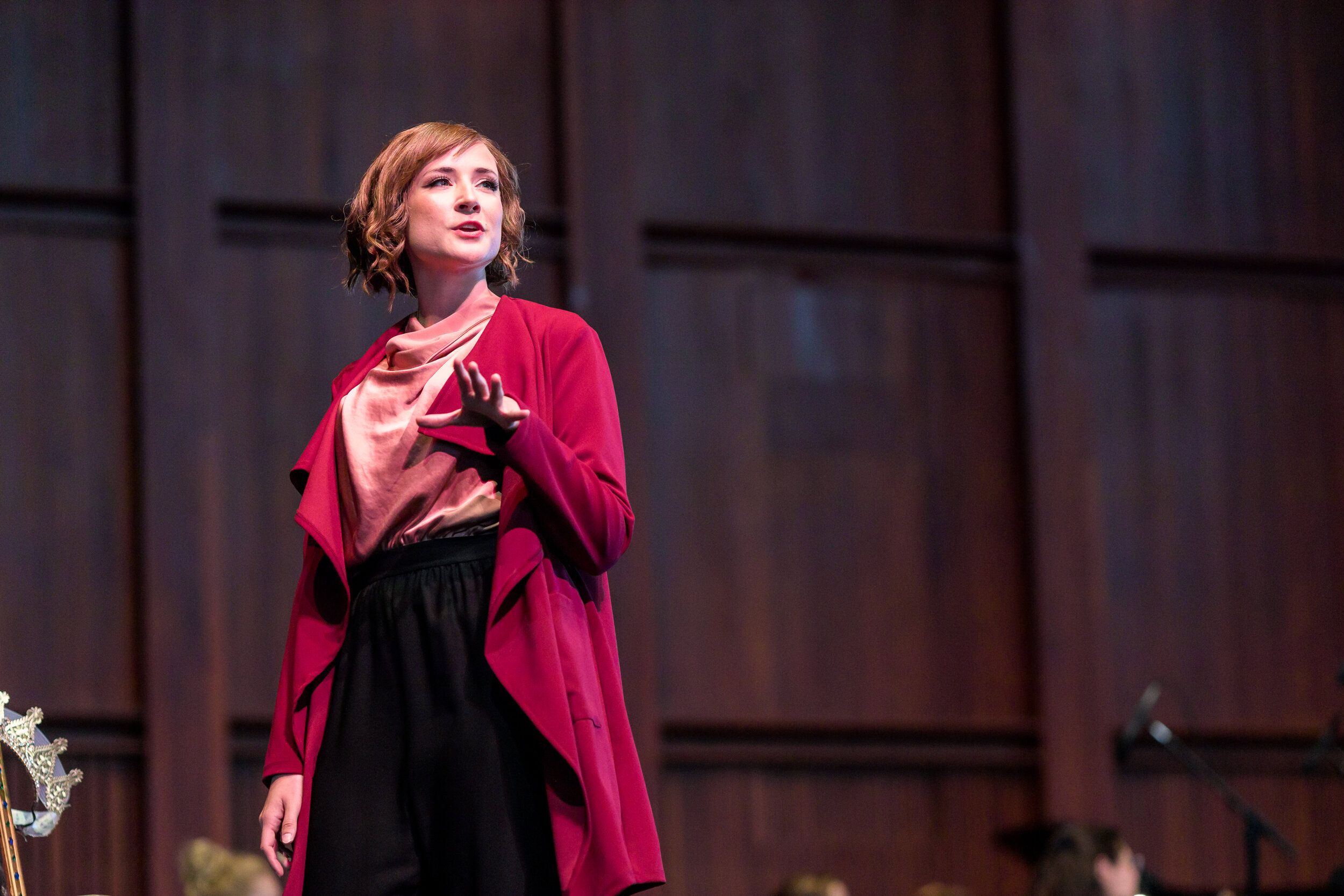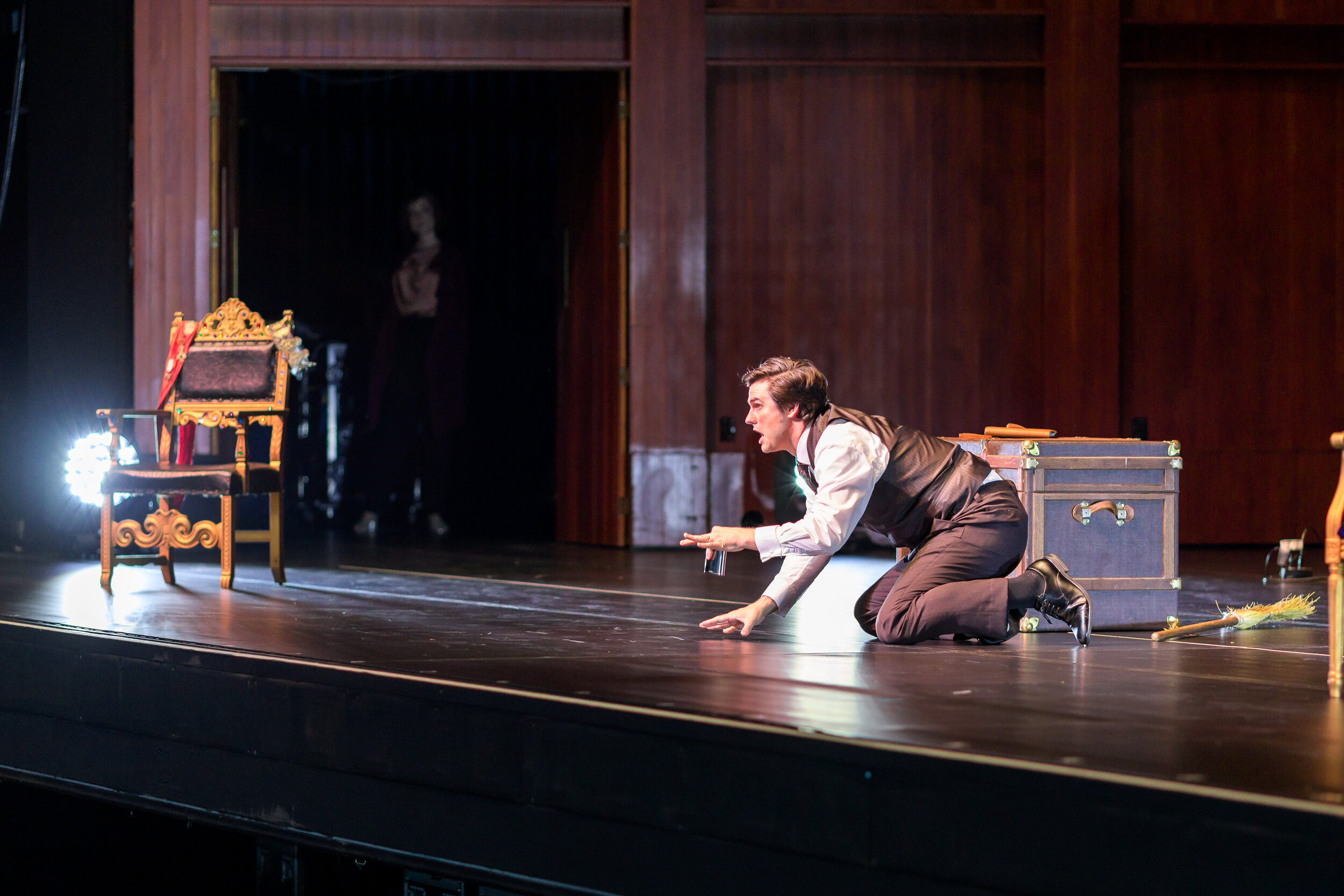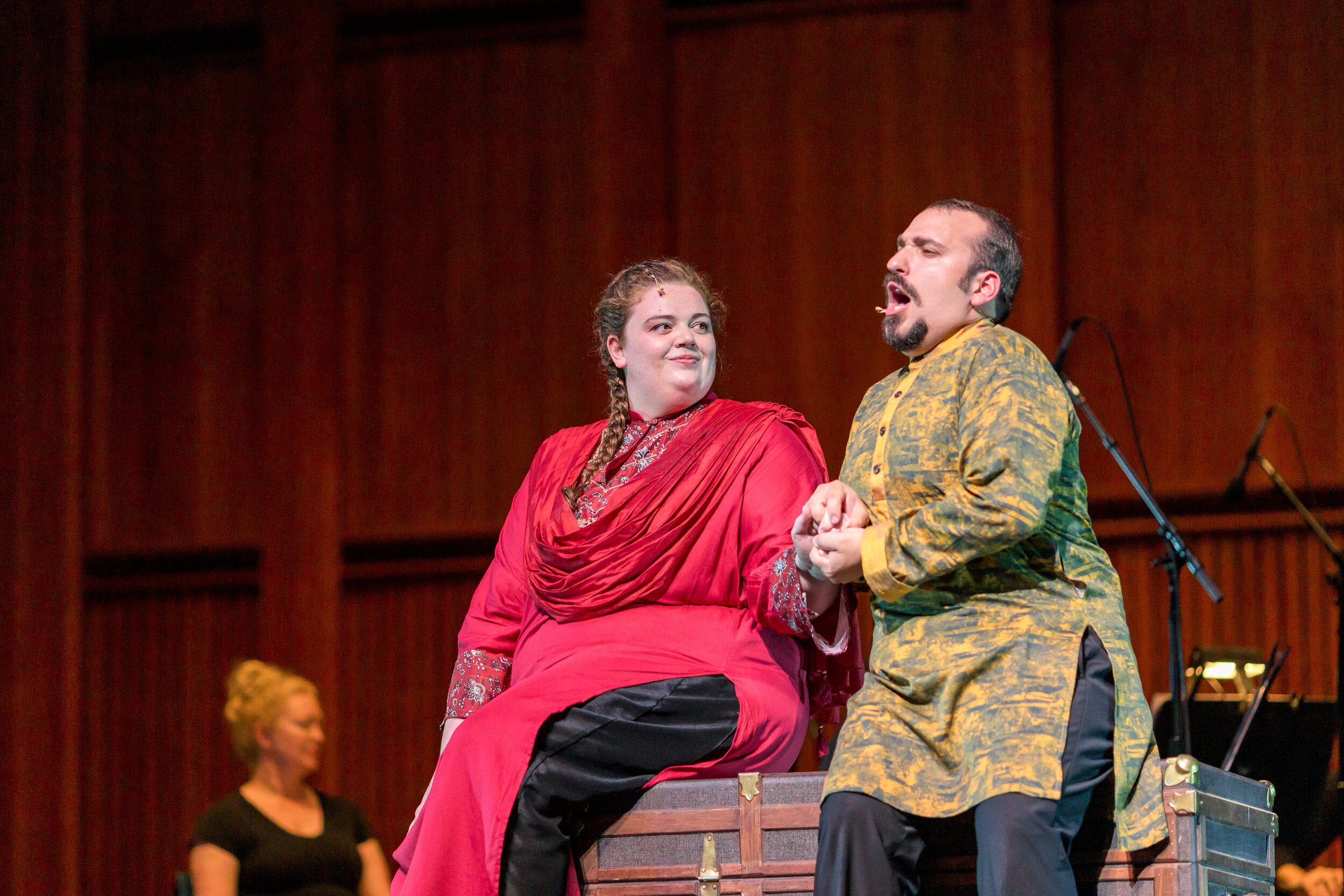I normally focus my blog reports on the performances of Wolf Trap Opera’s marvelously talented Filene and Studio Artists, and they were worthy once again. However, as I sat with my son in our pod in the Filene Center Friday night, socially distanced from other pods, and watched the performances in what I hope is our last pandemic season, I felt a profound awareness of how many individuals and their efforts that it took to fight through the difficulties and accomplish this program, to bring us this gift. The twin bill Friday night of Cinderella (Cendrillon) and Sāvitri was a mid-summer treat, and I will get to praising the coming of age of Alexandra Nowakowski as a headliner, the powerful vocals of Jonathan Bryan, and the steady performance of Leia Lensing as well as others, but first I also want to mention the contributions of the entire WTO team, whose range of talents, dedication, hard work, and courage made it possible to have summer entertainment this year and to enjoy vocal art live and in person once again.
Soprano Shannon Jennings as Marie (Cinderella), mezzo-soprano Gretchen Krupp as Areme (a stepsister), and soprano Yunuet Laguna as Maguelonne (a stepsister) in Pauline Viardot’s Cinderella (Cendrillon). Photo by A. E. Landes; courtesy of Wolf Trap Opera.
Cinderella (1904, Cendrillon in French) by composer Pauline Viardot was partially staged in concert format, another concession to pandemic restrictions. The players were in costume and acted out the drama with only a few on-stage props. Ms. Viardot received recognition for her operettas, and Cendrillon continues to be performed over the years. in her day, she was more famous as a leading mezzo-soprano. She was born into a musical family. Her father was a famous tenor, and her older sister was an even more renown soprano; both died when Pauline was young; she had to make her way in the world and was pushed by her mother into a singing career. I have encountered Ms. Viardot’s legacy before. She was influential in getting composer Charles Gounod’s first opera Sapho staged; in fact, she starred in its premiere (Washington Concert Opera performed Sapho in 2018). I think of her as the Oprah Winfrey of her day, talented as a performer but with an intelligence, personality, and eventually resources, that allowed her to attract a coterie of famous and wealthy artistic friends and to have great influence. She was also the librettist for her Cinderella, adapting Charles Perrault’s story along the lines of the Rossini opera, but with her own twists. Most notably, the fairy godmother in this version also provides running commentary on the action; it is a charming, witty version of the Cinderella story. Director Amanda Consol’s clever staging with what she had to work with was effective, especially with its comic touches – when the (imaginary) mice were released to be converted to (imaginary) horses off stage, she had them seemingly run across the stage with each singer hopping up to avoid them. The WTO twist of mixing in English dialog with French singing and dialog worked for me, drawing me into the farcical aspects of the telling; those fluent in French might have found it somewhat jarring.
Soprano Alexandra Nowakowski as La Fée, (the fairy godmother) and baritone Jonathan Bryan (the father). Photos by A. E. Landes; courtesy of Wolf Trap Opera.
Viardot’s operetta was composed to be performed in a salon before the well-known, even famous, musicians and composers of her day, rather a bold move, I think. I found her music to be pleasurable, especially as orchestrated by composer, conductor, and pianist David Hanlon, an impressive feat since Ms. Viardot wrote the score for piano accompaniment only. The music was played by twelve musicians: two string quartets, a bass, oboe/French horn, and two flutes, placed on stage seated behind the singers. The ensemble was ably led by Conductor Kelly Kuo. The oboe was used in a squawking manner to comically convey the difficulty of trying to get the stepsisters feet into the slipper Cinderella left behind at the ball.
Shannon Jennings’ bright clear soprano shone again as Marie (Cinderella); Christopher Bozeka’s rich tenor added appeal to his character who, in this version, was more Prince than Charming. Soprano Yunuet Laguna and mezzo-soprano Gretchen Krupp gave the distasteful stepsisters comic appeal, and tenor Joseph Leppek as the Prince’s aide was a crowd pleaser. However, there were two singers whose stars shone especially bright that night. I have seen soprano Alexandra Nowakowski perform before, both for WTO in Ariadne auf Naxos and for the Washington National Opera in The Magic Flute. Her talent was obvious in those roles. As La Fée, the fairy godmother, her stage manner was assured; her comic timing with the English dialog was spot on, and her voice and control, beautiful. Baritone Jonathan Bryan played the role of the father, a somewhat bumbling noveau riche fellow, addicted to the bottle (no mother in this version). His booming, resonant baritone is a force to be reckoned with, and enjoyed as often as possible. Women members of the WTO Studio Artists who rounded out the cast as fairies and sang in the chorus were pleasing additions to the performance. In fact, kudos to Chorusmaster William Woodard; the choral numbers were among the night’s highlights – so good to hear a chorus live again.
left photo: Mezzo-soprano Leia Lensing as Sāvitri and tenor Christopher Bozeka as Satyavān in Gustav Holst’s Sāvitri. right photo: bass Calvin Griffin as Death. Photos by A. E. Landes; courtesy of Wolf Trap Opera.
By contrast, Sāvitri (1921) only has three characters and was much shorter. It was also opposite in mood to Cinderella, intense, serious, and cerebral. It requires little staging and bends well to the concert format. The action is primarily the conversations between the three characters, somewhat Wagnerian in style. Death comes for Satyavān, the husband of Sāvitri in their woodland home. He succumbs, but Sāvitri’s ability to see through illusion (Māyā) impresses Death who offers her a wish that she cleverly uses to regain her husband’s life and demonstrate the power of love. Composer Gustav Holst took the story from an ancient epic poem, the “Mahabharata”. Holst, the famous composer of The Planets had a deep love for Indian culture, to the point of studying Sanskrit to be able to translate ancient texts. He also had an interest in Indian music, but it is not reflected in this work. Mr. Holst used two string quartets and an off-stage women’s chorus creating non-verbal sound, forging a somewhat ethereal and hymn-like quality to the music, spiritual in mood. The composer had asked that it be performed at dusk in an open-air setting. WTO complied.
Mezzo-soprano Leia Lensing has an emotionally imbued voice and the singing ability to carry the role of Sāvitri, and seemed to move through it flawlessly. Tenor Christopher Bozeka sang well as Satyavān as did bass Calvin Griffith, who projected Death scarily well. The vocals and music for Sāvitri are slow moving, pushing forward through the text. Beyond the story line, interest is created by the singers’ modulations and emphases. While I think, this cast did very well, I wish I could hear them perform Sāvitri again with about five more years of development under their belts. I suspect it will be even better.
So, something light-hearted and fun and then something serious to think about on the way home, provided in the beautiful setting of the Wolf Trap Farm Park for the Performing Arts, in the open-air Filene Center - a fine way to spend a midsummer’s eve. Wouldn’t you agree?
The Fan Experience: Opera has been one of the hardest hit professions in the country. Opera houses closed in March 2020 and are only now beginning to again offer live performances. Lee Anne Myslewski, Wolf Trap Vice-President for Opera and Classical Programming and her WTO staff have managed to keep their training program functioning under COVID-19 restrictions both last year and this, with online performances last year and Filene Center as well as online performances this year. Kudos and thanks to all involved. This summer would have been much tougher without the entertainment and connection they have provided.
The July 16 performance of Cinderella and Sāvitri was the only one. Wolf Trap Opera will offer a program called STARias on July 23, a concert of arias in the Filene Center by current opera stars who are alumni of WTO. WTO’s popular Jukebox Arias program remains available online. Opera fans will also want to note that soprano Renée Fleming will be appearing with the National Symphony Orchestra in concert on August 6 at Wolf Trap.
The Filene Center is not an ideal venue for opera, but an advantage is that its casual atmosphere draws in a younger crowd than one typically sees in the usual opera halls, often their first opera experience. There were even pockets of young children in the Filene Center for these performances. I was a little concerned early in Sāvitri when Death appeared and Satyavan died that it might be a little intense for them. Hopefully, parents had prepared them for the story line.
As I was watching Cinderella, I looked up at a scene on one of the monitors overhead and was reminded of watching The Anonymous Lover live streamed from the Filene Center and wished this program had been live streamed as well. So many more people could have benefited. Live stream is no match for being there in person, but if you can’t make it, watching live stream is also a fun and rewarding experience.
It has been a year and a half, two seasons ago, since Wolf Trap Opera has been able to mount opera performances before a live audience in The Barns at Wolf Trap, a much better venue for opera. I’ve enjoyed the Filene Center performances, but I can’t wait for a return of fully-staged opera in the small, intimate setting of The Barns with the audience close in to the young Filene and Studio Artists, performing without microphones. So many memories.





